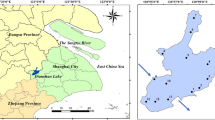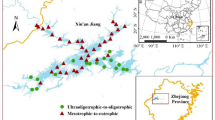Abstract
Remote sensing techniques is used to quantify the total suspended matter concentration (C TSM). In this study, we used remotely sensed data to retrieve the C TSM for the Taihu Lake, China, and developed an atmospheric correction algorithm especially for CBERS-02B CCD data. We simulated the remote sensing reflectance (R rs) of CCD bands using in-situ observations made in a cruise over the Taihu Lake in autumn 2004, from which a retrieval model is established with simulated R rs(830) and measured C TSM. In addition, we applied the atmospheric correction algorithm and retrieval model to process the CCD data over the lake in 2008 and to retrieve the C TSM. The RMS relative error between the C TSM retrieved from MODIS and from the CCD images is about 42.9%, indicating that algorithms described in this paper can be used for the application of CCD data in monitoring the C TSM distribution in the Taihu Lake.
Similar content being viewed by others
References
Austin R W. 1974. The remote sensing of spectral radiance from below the ocean surface. In: Jerlov N G, Steemann E ed. Optical aspects of oceanography, Academic Press, Nielsen, London and New York. Chapter 14.
Bailey S W, Werdell P J. 2006. A multi-sensor approach for the on-orbit validation of ocean color satellite data products. Remote Sensing of Environment, 102: 12–23.
Chavez Jr P S. 1988. An improved dark-object subtraction technique for atmospheric scattering correction of multispectral data. Remote sensing of Environment, 24: 459–479.
Cox C, Munk W. 1954. Measurement of the roughness of the sea surface from photographs of the sun’s glitter. J. Opt. Soc. Am., 44: 830–850.
Gordon H R, McCluney W R. 1975. Estimation of the depth of sunlight penetration in the sea for remote sensing. Applied Optics, 14: 413–416.
Gordon H R. 1976. Radiative transfer: a technique for simulating the ocean in satellite remote sensing calculations. Applied Optics, 15: 1 974–1 979.
Gordon H R. 1978. Removal of atmospheric effects from satellite imagery of the ocean. Applied Optics, 17: 1 631–1 636.
Gordon H R, Clark D K. 1981. Clear water radiance for atmospheric correction of coastal zone color scanner imagery. Applied Optics, 20: 4 175–4 180.
Gordon H R, Brown J W, Robert H E. 1988. Exact Rayleigh scattering calculations for use with the Nimbus 7 Costal Zone Color Scanner. Applied Optics, 27: 862–871.
Gordon H R, Wang M H. 1994a. Retrieval of water-leaving radiance and aerosol optical thickness over the oceans with SeaWiFS: a preliminary algorithm. Applied Optics, 33: 443–452.
Gordon H R, Wang M H. 1994b. Influence of oceanic whitecaps on atmospheric correction of ocean color sensors. Applied Optics, 33: 7 754–7 763.
Gordon H R. 1995. Remote sensing of ocean color: a methodology for dealing with broad spectral bands and significant out-of-band response. Applied Optics, 34: 8 363–8 374.
Jiang X W, Tang J W, Zhang M W et al. 2009. Application of MODIS data in monitoring suspended sediment of Taihu Lake, China. Chinese Journal of Oceanology and Limnology, 27(3): 614–620.
Liu L M, Zhang H M, Zhang F. 2007. Atmospheric correction of MODIS imagery for turbid coastal waters. Geomatics and Information Science of Wuhan University, 32: 104–107. (in Chinese)
Ma R H, Tang J W, Dai J F et al. 2006. Bio-optical model with optimal parameter suitable for Lake Taihu in water colour remote sensing. International Journal of Remote Sensing, 27: 4 303–4 326.
Ma R H, Song Q J, Tang J W et al. 2007. A simple empirical model for remote sensing reflectance of Lake Taihu waters in autumn. Journal of Lake Sciences, 19: 227–234. (in Chinese)
Ma R H, Kong F X, Duan H T et al. 2008. Spatio-temporal distribution of cyanobacteria blooms based on satellite imageries in Lake Taihu, China. Journal of Lake Sciences, 20: 687–694. (in Chinese)
May C L, Koseff J R, Lucas L V et al. 2003. Effects of spatial and temporal variability of turbidity on phytoplankton blooms. Marine Ecology. Progress Series, 254: 111–128.
Mobley C D. 1994. Light and water-radiative transfer in natural waters. Academic Press, California. p. 60–80.
Morel A, Prieur L. 1977. Analysis of variations in ocean color. Limnol. Oceanogr., 22: 709–722.
Morel A, Gordon H R. 1980. Report of the working group on water color. Boundary-Layer Meteorology, 18: 343–355.
Sathyendranath S, Prieur L, Morel A. 1989. A three-component model of ocean color and its application to remote sensing of phytoplankton pigments in coastal waters. International Journal of Remote Sensing, 10: 1 373–1 394.
Smith R C, Wilson W H. 1981. Ship and satellite bio-optical research in the California Bight. In: Oceanography from Space, J F R Gower ed. Plenum Press, New York and London. p. 281–294.
Sturm B. 1981. Ocean color remote sensing and quantitative retrieval of surface chlorophyll in coastal waters using NIMBUS CZCS data. In: Oceanography from Space, J F R Gower ed. Plenum Press, New York and London. p. 267–279.
Tang J W. 1999. The simulation of marine optical properties and color sensing models. PhD Dissertation. Institute of Remote Sensing Applications, Chinese Academy of Sciences, Beijing. p. 113–151.
Teodoro A C, Veloso-Gomes F, Goncalves H. 2007. Retrieving TSM concentration from multispectral satellite data by multiple regression and artificial neural networks. IEEE Transactions on Geoscience and Remote Sensing, 45: 1 342–1 350.
Wang M H, Bailey S W. 2001. Correction of sun glint contamination on the SeaWiFS ocean and atmosphere products. Applied Optics, 40: 4 790–4 798.
Zhang M W, Tang J W, Ding J. 2009. Advances in studies on atmospheric correction algorithm in remote sensing retrieval for Case 2 waters. Advances in Marine Science, 27: 266–274. (in Chinese)
Zhou G. 2007. Research of simulation of water optical properties and remote sensing inversion of inland water quality parameter. PhD Dissertation. Institute of Remote Sensing Applications Chinese Academy of Sciences, Beijing. p. 107–157. (in Chinese)
Author information
Authors and Affiliations
Corresponding author
Additional information
Supported by the National Basic Research Program of China (973 Program) (No. 2009CB723903)
Rights and permissions
About this article
Cite this article
Zhang, M., Dong, Q., Tang, J. et al. Evaluation of the retrieval of total suspended matter concentration in Taihu Lake, China from CBERS-02B CCD. Chin. J. Ocean. Limnol. 28, 1316–1322 (2010). https://doi.org/10.1007/s00343-010-9948-7
Received:
Accepted:
Published:
Issue Date:
DOI: https://doi.org/10.1007/s00343-010-9948-7




